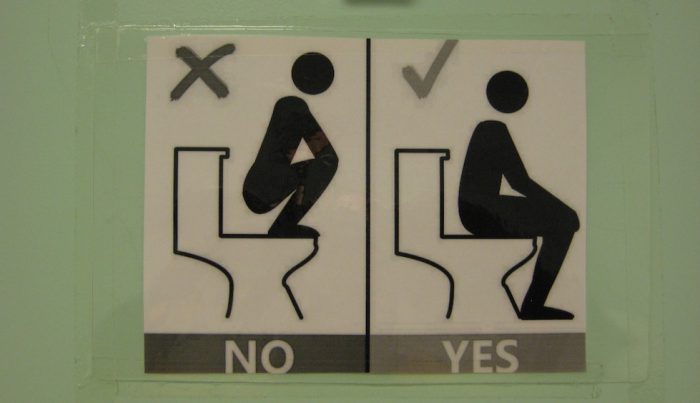*Editor’s Note: Elephant is not your doctor or hospital. Our lawyers would say “this web site is not designed to, and should not be construed to provide medical advice, professional diagnosis, opinion, or treatment to you or any other individual, and is not intended as a substitute for medical or professional care and treatment. Always consult a health professional before trying out new home therapies or changing your diet.” But we can’t afford lawyers, and you knew all that. ~ Ed
How are your poops?
Most of us aren’t completely satisfied! And the surprising reason may be our pooping position.
President Jimmy Carter was made infamous in a 1978 article in Time magazine discussing how the president had to miss a day of work due to hemorrhoids. President Carter’s doctor explained, “We were not meant to sit on toilets, we were meant to squat in the field.”
Since then, much debate has arisen with regard to potential health concerns of using modern sit-down toilets versus the time-tested technique of squatting during a bowel movement. For millions of years, humans had been squatting to poo. The first flushing toilet was invented in 1596. Only the very wealthy could enjoy the luxury of a “throne.” According to Smithsonian magazine, toilets of any kind, short of a hole in the ground, did not become commonplace until 1851—making a sitting toilet still quite a new thing.
What About the Recto-Anal Angle?
Since our ancestors squatted, researchers have asked the question as to whether sitting or squatting is the better method of defecation or moving bowels. Many studies have been done, and the ancestral method of squatting is ripe with advantages. For example, in one study, researchers measured the recto-anal angle during squatting and sitting. This is the angle between the rectum, which is the last portion of the large intestine, and the anus, which is the rectal opening.
The results of this study suggest that the greater the hip flexion achieved by squatting, the straighter the recto-anal canal will be, and, accordingly, less strain will be required for defecation. In other words, during sitting, this angle is acute, meaning that feces must make a sharp turn to find the toilet compared to squatting, which allows the bowels to empty in a straight line.
In another study, sitting contracts the puborectalis muscle, literally choking the rectum. Squatting relaxes this muscle, allowing the rectum to empty in a straight line.
That Complete Elimination Feeling
One of the measures of occasional constipation is not having the sensation of complete elimination. One study identified a possible cause, showing that chronic tightening of the puborectalis muscle can cause permanent indentation of the rectum, which has been linked to issues related to healthy and normal complete bowel elimination.
In another study, 28 healthy volunteers between 17 and 66 were asked to use a digital timer to record the time needed on the toilet to have a satisfactory bowel movement and the intensity of the bowel movement while sitting compared to squatting.
The study concluded that the time needed to have a satisfactory bowel emptying and the degree of strain in the squatting position were reduced sharply in all volunteers compared with sitting.
Benefits of Squatting During Bowel Movements
>> It makes evacuation faster and more convenient.
>> It prevents “fecal stagnation,” a causative factor for irritable bowel syndrome, inflammatory bowel disease, appendicitis, and other bowel function imbalances.
>> It guards the pelvic nerves from becoming stretched and damaged. These control the urogenital organs, such as the prostate, bladder, and uterus.
>> It temporarily blocks the ileocecal valve (between the colon and the small intestine), leaving minimal or no chance of contaminating the small intestine.
>> It maintains continence by relaxing the puborectalis muscle (which usually chokes the rectum).
>> The colon is supported by the thighs, which prevent straining and, in turn, prevent hernias and pelvic organ prolapse.
>> It is a strongly recommended noninvasive treatment in the case of hemorrhoids.
>> Squatting is also useful for pregnant females by avoiding the pressure exerted on the uterus when using the toilet.
>> Regular squatting is beneficial for natural delivery.
>> Clinicians often advise patients suffering from hemorrhoids to squat for bowel evacuation regularly. It is also evident that diseases such as hemorrhoids are very uncommon in countries where people squat for defecation, although a causal relationship has not been fully established.
>> Due to straightening of the anorectal angle during squatting, it reduces defecation time (i.e., one minute, compared to 4 to 15 minutes in the sitting position) and frequency of straining episodes.
>> Allows smooth evacuation of feces with minimum straining effort.
Learn How to Squat on a Toilet
Bringing the knees up while on the toilet is key to enjoying the anatomical benefits of squatting while moving the bowels. The higher the knees toward the chest, mimicking the position of squatting on the floor, the better. This can be replicated by putting a small stool in front of the toilet that will put you into a squatting position while still sitting on the toilet itself. This is a half-squat, half-sit position good for beginners.
The stool also gives the option to be in a full squat position with all your weight on your feet and the buttocks raised above the toilet. While any foot stool will get you into the correct position, there are many stools designed specifically for this.
What’s your favorite pooping position? Let us know!
~
Get Our Podcast:












Read 3 comments and reply